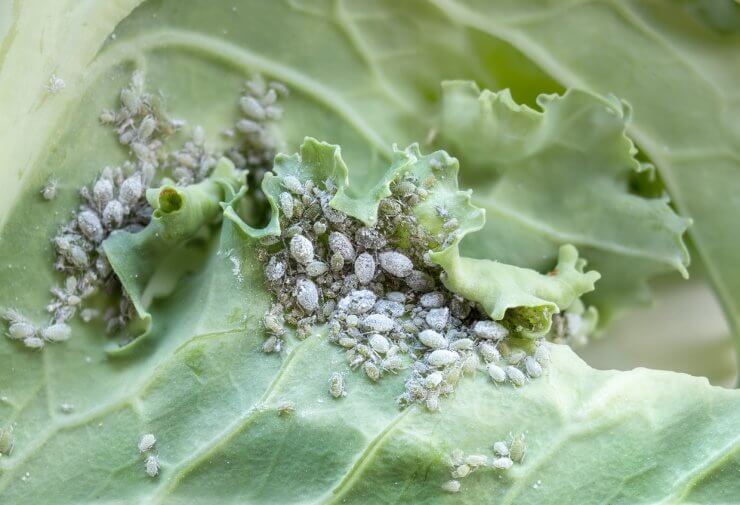
Cabbage aphids on kale leaf
Pests on your kale plant, left unchecked, can damage and destroy your crop. Keeping a close watch on your plants during regular daily inspections will help you spot any pests before they can do irreparable harm.
Spot the symptoms of kale plant pests
Check your kale for these symptoms of pests on the prowl.
On Kale Leaves and Stems
| Symptoms | Pest |
|---|---|
| Plants wilt and shrivel; when you pull up the plants, you can see rice-size white maggots feeding on the roots Cabbage root maggot | Plants wilt and shrivel; when you pull up the plants, you can see rice-size white maggots feeding on the roots Cabbage root maggot |
| Holes in plant leaves; destroyed seedlings | Slugs; Snails |
| Black deposits of “honeydew” | Cabbage aphids |
| Holes in leaves or stems | Cabbage loopers |
| Holes in plant leaves | Diamondback moth/cabbage moth |
| Holes on the underside of leaves, visible from the top | Diamondback moth |
| Seedlings cut off at soil level | Cutworms |
| Yellowing leaves; clusters of small “bumps” on underside of leaves | Aphids |
| Tiny holes in leaves | Flea beetles |
| Leaves appear silver and distorted | Thrips |
| Plants wilt in the afternoon sun, grow unevenly, appear stunted; roots have galls | Nematodes |
How to treat pests on kale plants
Here are some proven ways to get rid of pests on your kale plants. Choose the best treatment for the type of pests invading your trees.
- Pick off the pests. Use your garden gloves to remove the pests by hand. After removal, destroy pests by drowning them in a bucket of soapy water or crushing them with your foot. Handpicking isn’t efficient or practical for very small pests, but works well with larger pests.
- Apply insecticidal soap. Insecticidal soap is organic. The potassium salts in insecticidal soap help remove an insect’s protective waxes, causing destruction of insect membranes and killing them. Mix the soap with water to create your solution, and apply directly to insects on any plants. While insecticidal soap is less apt to affect other organisms, certain plants might be sensitive to the soap and can suffer leaf burn.
- Apply horticultural oils. Combine plant- or petroleum-based oils with water to produce horticultural sprays. Neem oil, for instance, is derived from seed extracts of the neem plant. Oil-based sprays block an insect’s air holes, interfere with an insect’s metabolism, disrupt insect feeding, and inhibit insect growth. Like insecticidal soaps, horticultural oils can cause plant injury if not properly diluted.
- Make your own pest spray. You can make your own pest spray with benign materials. Mix 1 tablespoon of baking soda, 1/2 teaspoon of a mild dish detergent, and 2 1/2 tablespoons of olive oil in a gallon of water to make a solution that will repel all kinds of bugs, as well as a fungicide for blight and mildew on kale plant leaves. Shake it well in your bottle before spraying and repeat every week for it to be continuously effective.
- Create a pest barrier. A floating row cover is one way to protect your plants from pests that jump and flit from plant to plant. For thrips, lay down reflective mulch early in the season; it will confuse them and they’ll move on.
Do pests attack your kale plants every year? How do you handle removing them—and even preventing them in the first place? Please tell us how you treat your kale plants to avoid pests.


 Previous
Previous


Does reflective mulch protect other plants from thrips?